Medu Vada is a popular South Indian breakfast snack of donut shaped lentil fritters that are fluffy, crispy, soft and delicious. If sweet breakfast isn’t your thing, try this recipe for savory spiced donuts made with black gram lentils, spices and herbs. Traditionally paired with Sambar and Coconut Chutney, these make for a comforting, filling and satisfying breakfast or snack.
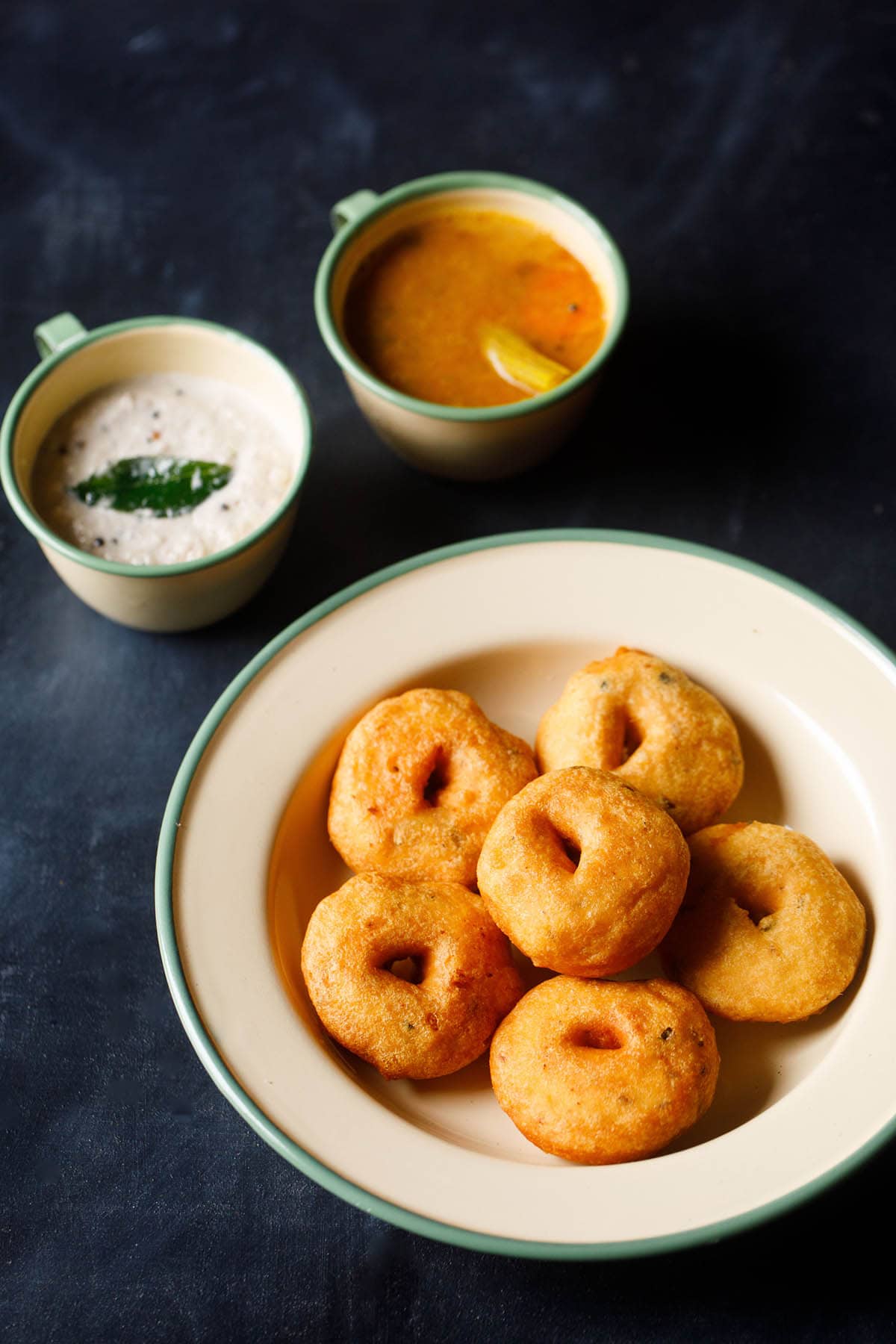
About Vada
If you’re in India and you come across ‘vada’ or ‘bada,’ you must know that this is a category of savory snacks, which are usually fried. Largely, some different variations of these vadas can be classified as cutlets, fritters, dumplings or donuts.
A typical vada can be made using lentils or legumes, vegetables, sago or a combination of all, along with veggies, seasonings, spices and herbs that are added to enhance the taste, texture and nutritive value. Some vada versions include Dahi Vada, Sabudana Vada, Maddur Vada and more.
Vadas found in different regions of India have their own name. For instance, vade, wada, bara, wadeh or vadai. According to the famous Indian food scientist and historian and nutritionist K. T. Achaya, vadai was very common during 100 BCE-300 CE amongst Tamils.
All these various vada have different recipes and methods of preparation. Mostly in many variations, the lentils are soaked and then ground to make a batter. In some variations like in Batata Vada recipe the batter is made from dry gram flour rather than whole lentils with a spiced savory potato stuffing encased inside.
While the term vada is often used interchangeably with medu vada, it should be noted that medu vada is part of the vada family, but not all vada are medu vada. Example this Dal Vada recipe is made with a spiced, savory chana dal batter.
About Medu Vada Recipe
Medu vada is one of my favorite snacks of all time. I loved them as a kid, and they clearly withstand the test of time because they are still one of my most beloved dishes. I love most South Indian snacks because they remind me of my growing up days.
Want more delicious South Indian breakfast tiffin recipes? Try my Rava Dosa, Idli or Masala Dosa!
Medu vada are essentially savory donuts made with black gram, herbs, coconut and spices. The word medu means soft and vada means fritters in Kannada language. This particular type of fritter is also known as:
- Urad Dal Vada in Hindi
- Garelu in Telugu
- Uzhunnu Vada in Malayalam
- Uddina Vada in Kannada
- Medhu Vadai, Ulundu Vadai in Tamil
The hero ingredient in medu vada recipe is urad dal (skinned black gram), but the herbs and spices also add a savory and spicy quality to these fritters that is absolutely addictive. The hotel-style medu vada also includes onions, which lend a lovely sweetness.
If you are making these for kids, you can consider adding extra veggies like grated carrots, shredded cabbage, or grated beetroot to sneak in a little extra nutrition. Hidden vegetables are still vegetables!
I especially like serving the crispy, fluffy medu vada or garelu the traditional way: dunked in hot sambar with coconut chutney by the side.
This popular, satisfying meal that is also called sambar vada with coconut chutney is very famous all over India. It tastes awesome, so is loved by many.
Whenever I make medu vada, I go the extra length to make sambar. While you’re free to serve them with only coconut chutney, vada sambar is one of those joyful foods that bring up many wonderful memories. Don’t you agree?
You can enjoy piping hot vada with any variety of Sambar.
But if you are pressed for time, simply serve with coconut chutney, mint coriander chutney or tomato ketchup.
You could also use any savory or spicy dip of your choice. Remember that medu vada or garelu are fritters, so they’re going to taste delicious no matter what!
Mastering this classic Medhu Vadai recipe does take time and some experience. Making the doughnut shape from the batter is the most difficult step.
Not to worry: I also struggled with it in my earlier days of cooking! Below I share all my tips and tricks that I have learned over the years. I hope you enjoy making them as much as I do.
Are you ready to make the absolute best vada recipe with a light, porous texture inside and crispy on the outside? Just take a look at the photo below. Isn’t the texture incredibly fluffy and soft like a cloud? Yum!
Come along with me in the kitchen and I’ll show you how to make this classic South Indian snack with easy to follow step-by-step photos.
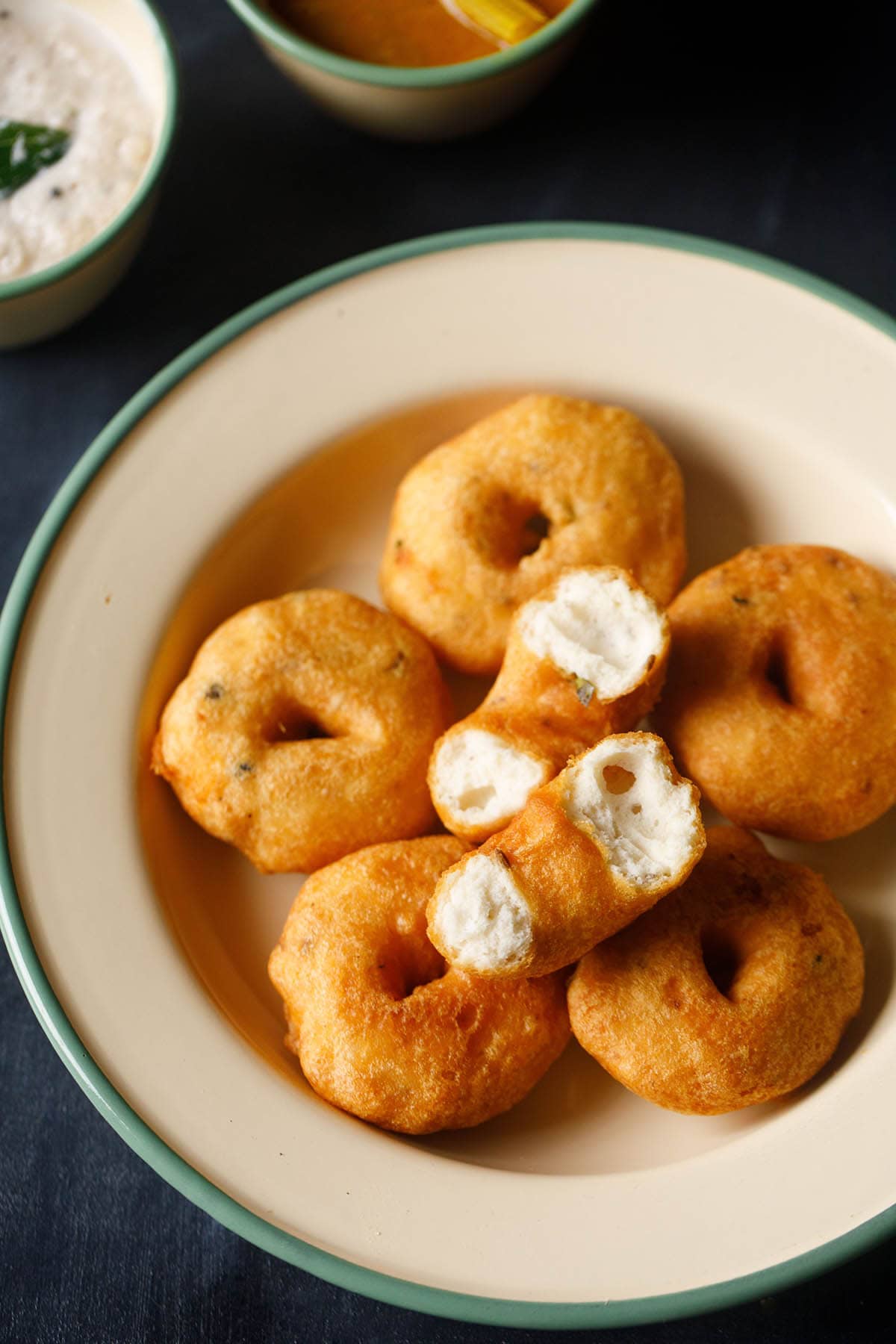
How to make Medu Vada
Soak Lentils
1. Rinse 1 cup urad dal (husked and split or whole black gram) a few times in water. Then soak the lentils in 2.5 to 3 cups water for at least 4 to 5 hours or up to overnight.
Preferably use unpolished urad dal to make this vada recipe.
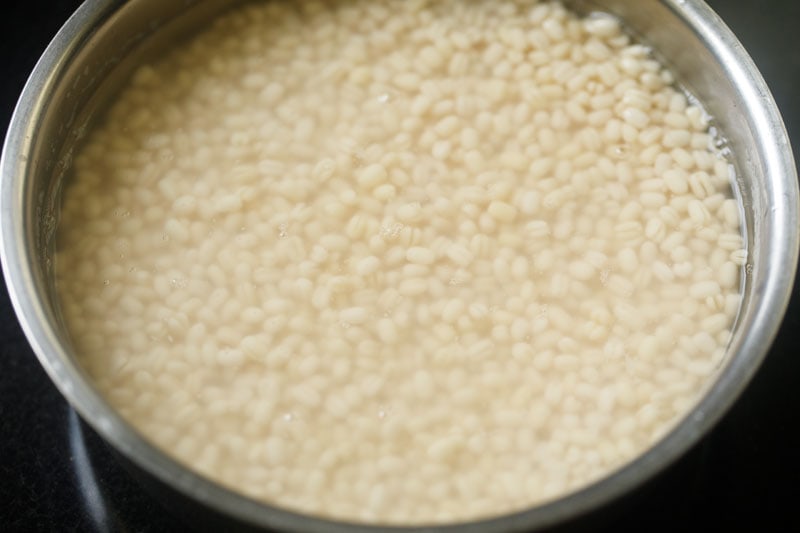
2. Drain and discard the water. Add the soaked urad dal to a grinder jar. Add 3 to 4 tablespoons fresh water or as needed. Just be sure not to make the batter too thin!
Do not add too much water while grinding. The batter should be like a soft moist dough but yet light and fluffy.
It should end up looking like a cake batter rather than a crepe batter. I recommend blending in steps and adding water as needed to achieve the right consistency.
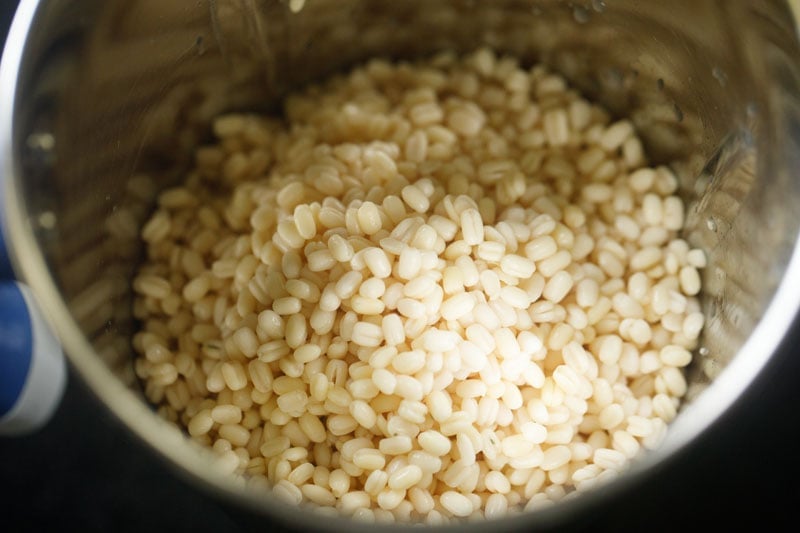
Make Urad Dal Batter
3. Begin to grind or blend the urad dal to a smooth batter. The batter should be fluffy and thick.
You can grind in two batches or one lot depending on the capacity and size of your blender or mixer-grinder.
Scrape down the sides of the blender as you go to ensure all the lentils gets blended to a uniform consistency.
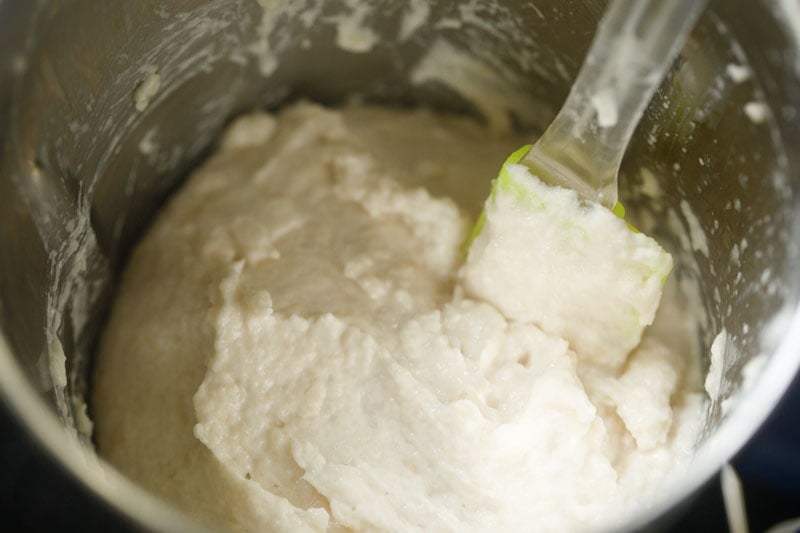
4. Continue to grind at intervals by scraping the sides with a spatula. If your mixer or grinder becomes hot, then wait for a few minutes until it cools down.
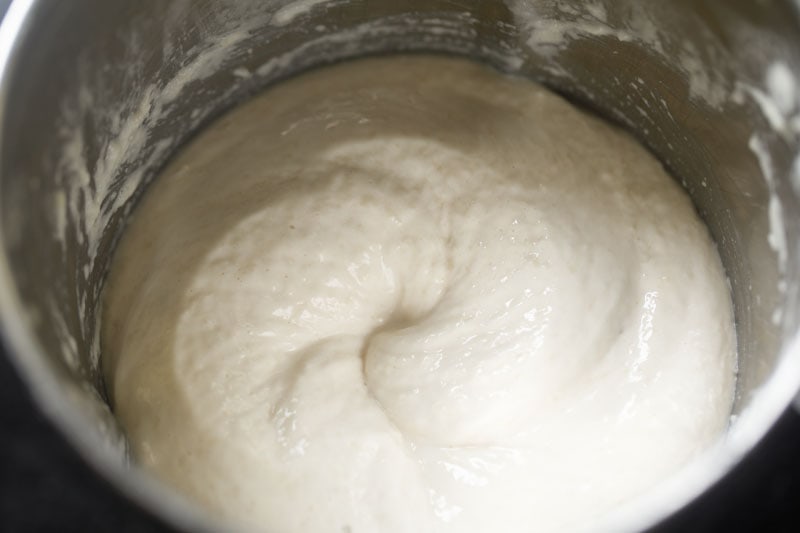
5. Continue to grind or blend until you achieve a smooth, fluffy batter. Remember there should be no fine grits or chunks of urad dal in the batter.
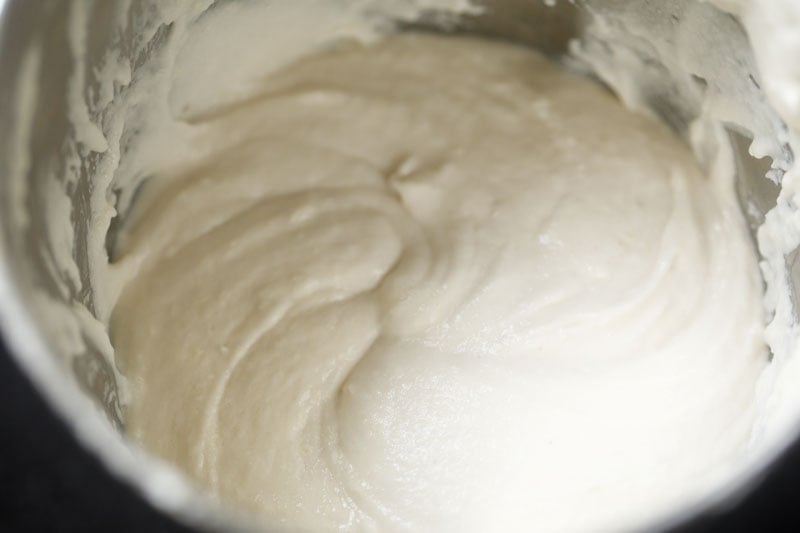
6. Remove the batter into a big bowl or vessel. Then briskly whip with a spatula, spoon or a wired whisk for 2 to 3 minutes. This aerates the batter and gives it a light, fluffy texture.
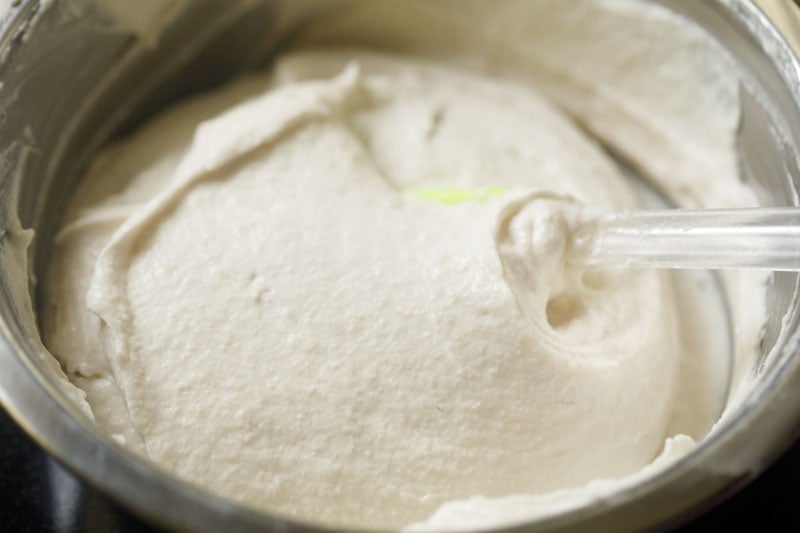
7. In the below photo you see the vada batter that has been aerated by continuously whisking it for few minutes.
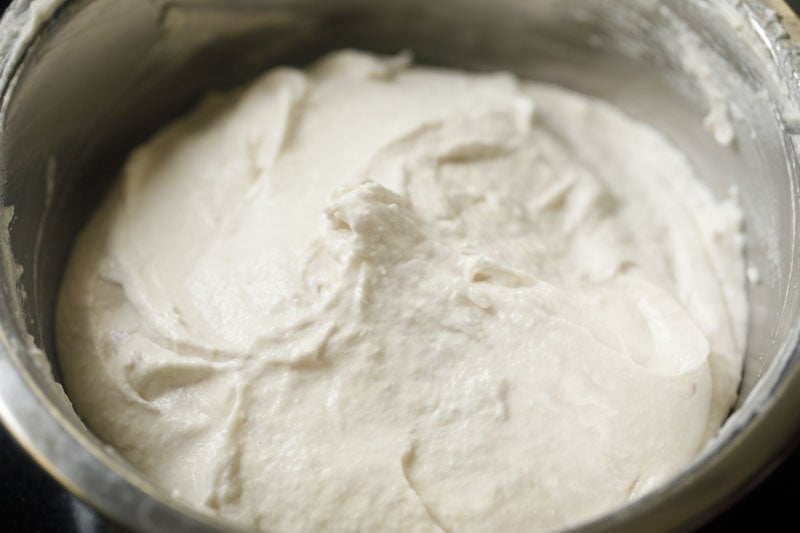
Check Batter Consistency
8. A quick way to check the perfect and right consistency of the batter is to add a small spoon of it in a bowl of water. The batter should float and remain intact. If it floats and does not get dissolved, then you have achieved the right consistency.
If it sinks, this means that your batter is not fluffy enough (with not enough air bubbles trapped in it) or is too thin.
If the batter is too thin, then add some semolina (fine rava or suji) or urad dal flour or rice flour to it to help thicken it up. Rava or suji also helps in giving a crispy texture to the vada.
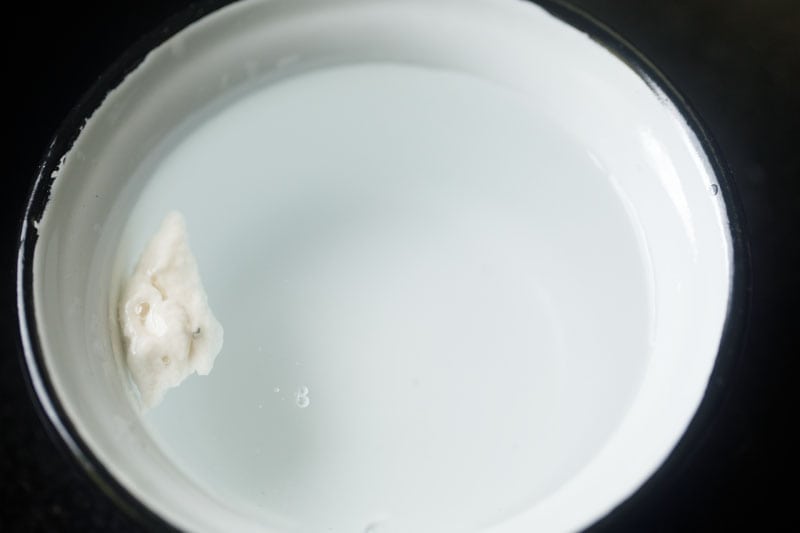
Add Spices, Herbs to Vada Batter
9. Measure and keep all the ingredients ready for making the batter. To the batter, add the following spices and herbs:
- 1 tablespoon chopped curry leaves
- 1 teaspoon finely chopped green chillies
- 1 teaspoon finely chopped ginger
- 1 pinch asafoetida
- ½ teaspoon cumin seeds
- ½ teaspoon lightly crushed black pepper – can use whole peppercorns as well. The addition of black pepper gives a good taste but is optional.
- ½ teaspoon salt or as required
You can also add ⅓ cup finely chopped onions or shallots; 2 tablespoons of chopped coriander leaves and ¼ cup chopped fresh coconut pieces.
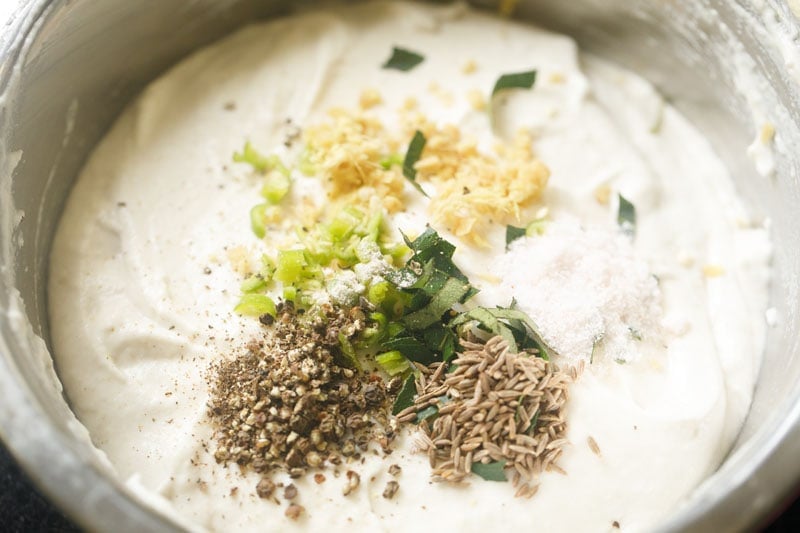
10. Mix the batter well with the herbs, spices and salt. You do not have to ferment the batter. You can use it right away. Check the taste of the batter and, if needed, add some salt.
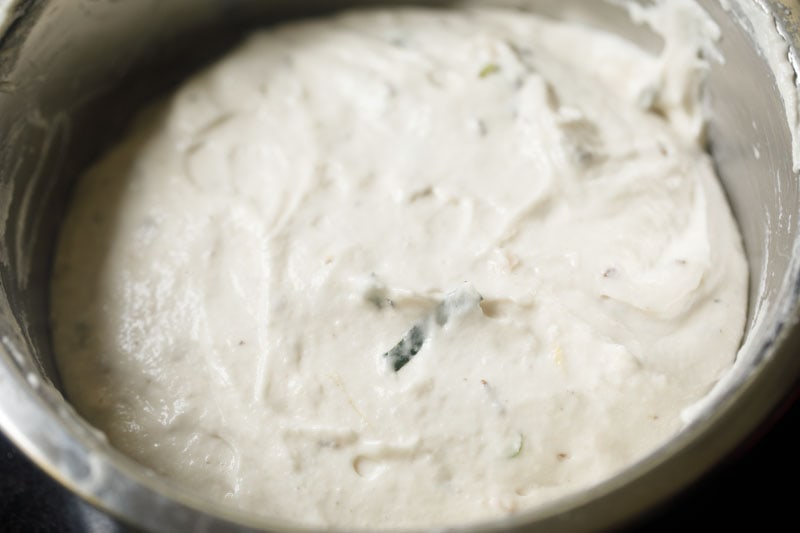
Shape Batter
11. Take a bowl of water. Apply some water from the bowl on both your palms. Take some batter in your right palm from the bowl. Give it a round shape by moving it in a circular position in the right hand.
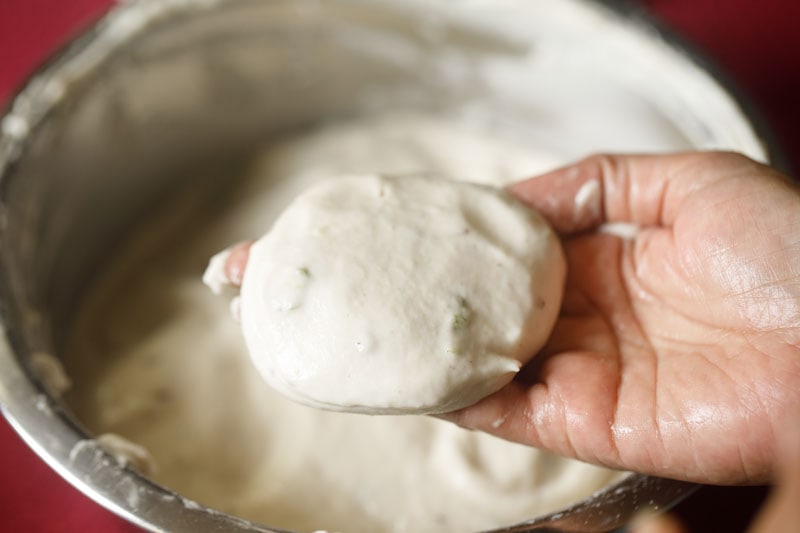
12. With your thumb make a hole in the center. You can also use banana leaves or zip lock bags to give the medu vada its doughnut shape.
Tip: If the batter sticks and you are not able to shape it then add 1 to 2 tablespoons of rice flour to the batter and mix well. This happens if the batter has become slightly thin which means that there is more water in it.
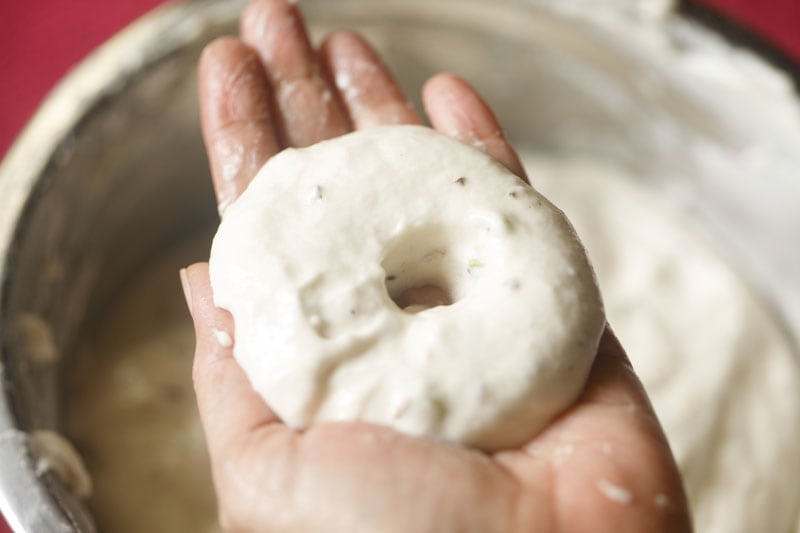
Fry Medhu Vadai
13. In a kadai, heat oil over medium heat. Once the oil becomes hot, slide the medu vada gently into the hot oil. Be careful here! The oil can sputter and pop over quite a distance, so I recommend wearing an apron and long sleeves to protect your skin and clothes.
Tip: If you do not care about the appearance of the doughnut shape of the medu vada, then just drop spoonfuls of the batter directly in the oil.
Do not overcrowd the pan. Work in batches, considering the size of your pan as your guide.
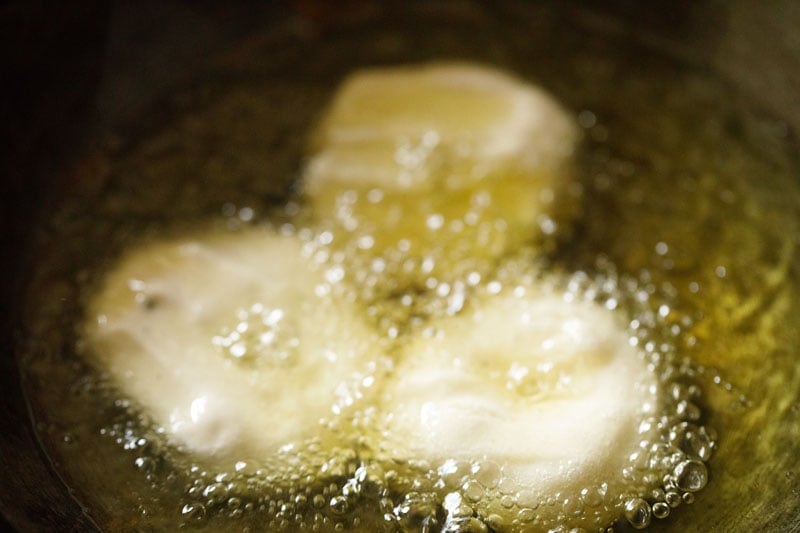
14. Once the vada or garelu are slightly golden and the batter has firmed up and looks crispy, then gently turn over with a slotted spoon and continue to fry.
The oil should not exceed 190 degrees celsius (375F), or fall below 175 degrees celsius (350F).
Remember: oil that is too hot will quickly brown the vada from the outside, but they will remain uncooked from inside. Oil that isn’t hot enough will make the vada absorb too much oil and become greasy.
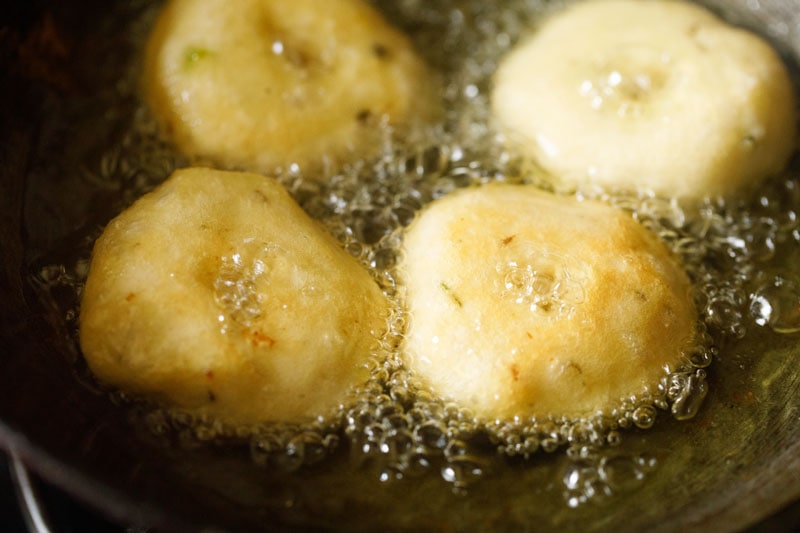
15. Continue to fry the vada, turning over as needed.
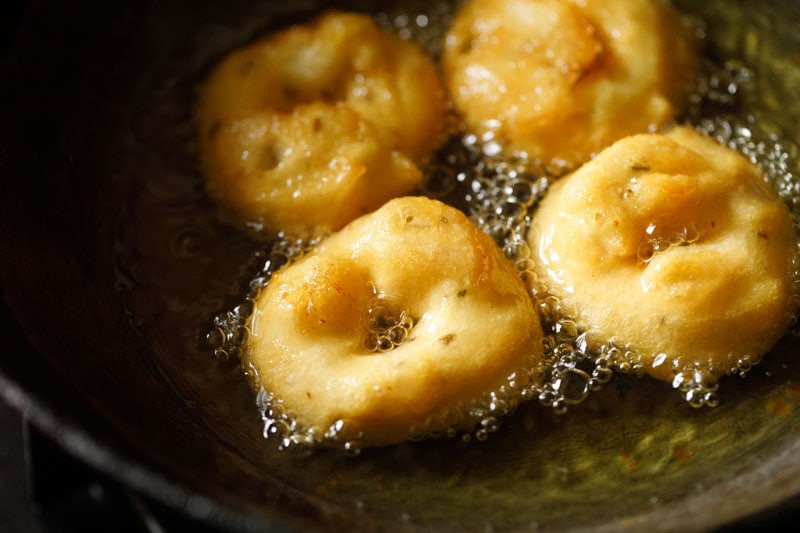
16. Fry the medhu vadai till crisp and golden.
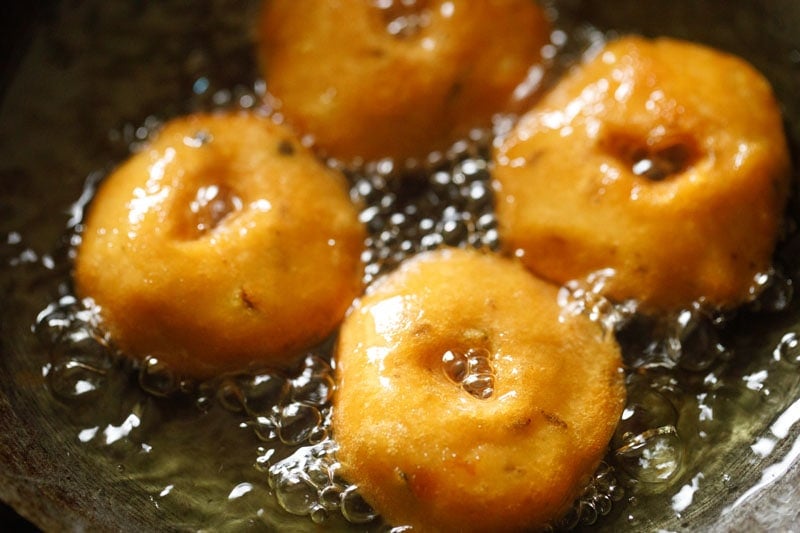
17. Once the medhu vadai is crisp and golden, then remove with a slotted spoon to drain the extra oil. Fry the rest of vadai in the same manner.
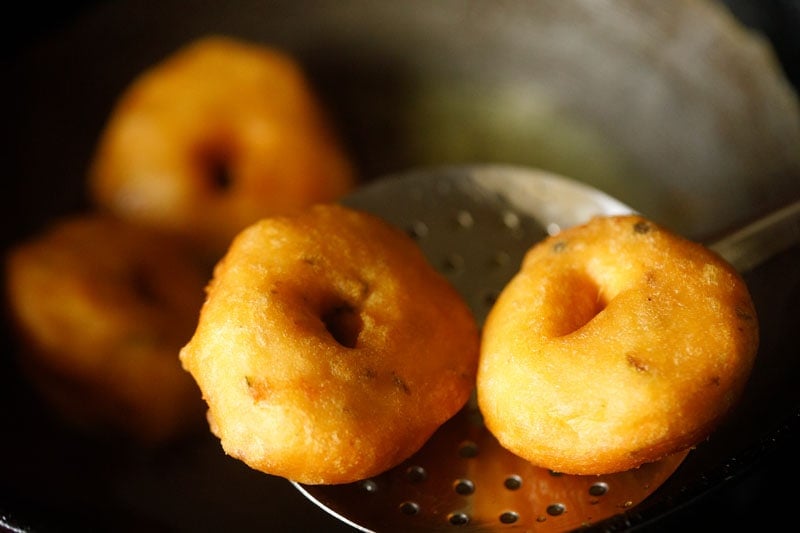
18. Drain them on kitchen tissues to remove extra oil. This way shape the vada batter and fry them in hot oil.
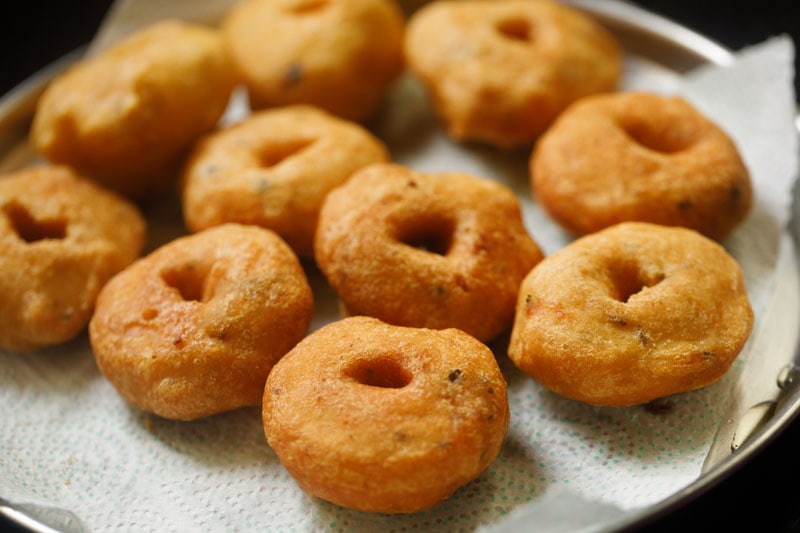
19. Serve Medu Vada or Garelu or Uzhunnu Vada hot or warm with sambar and coconut chutney. Enjoy!
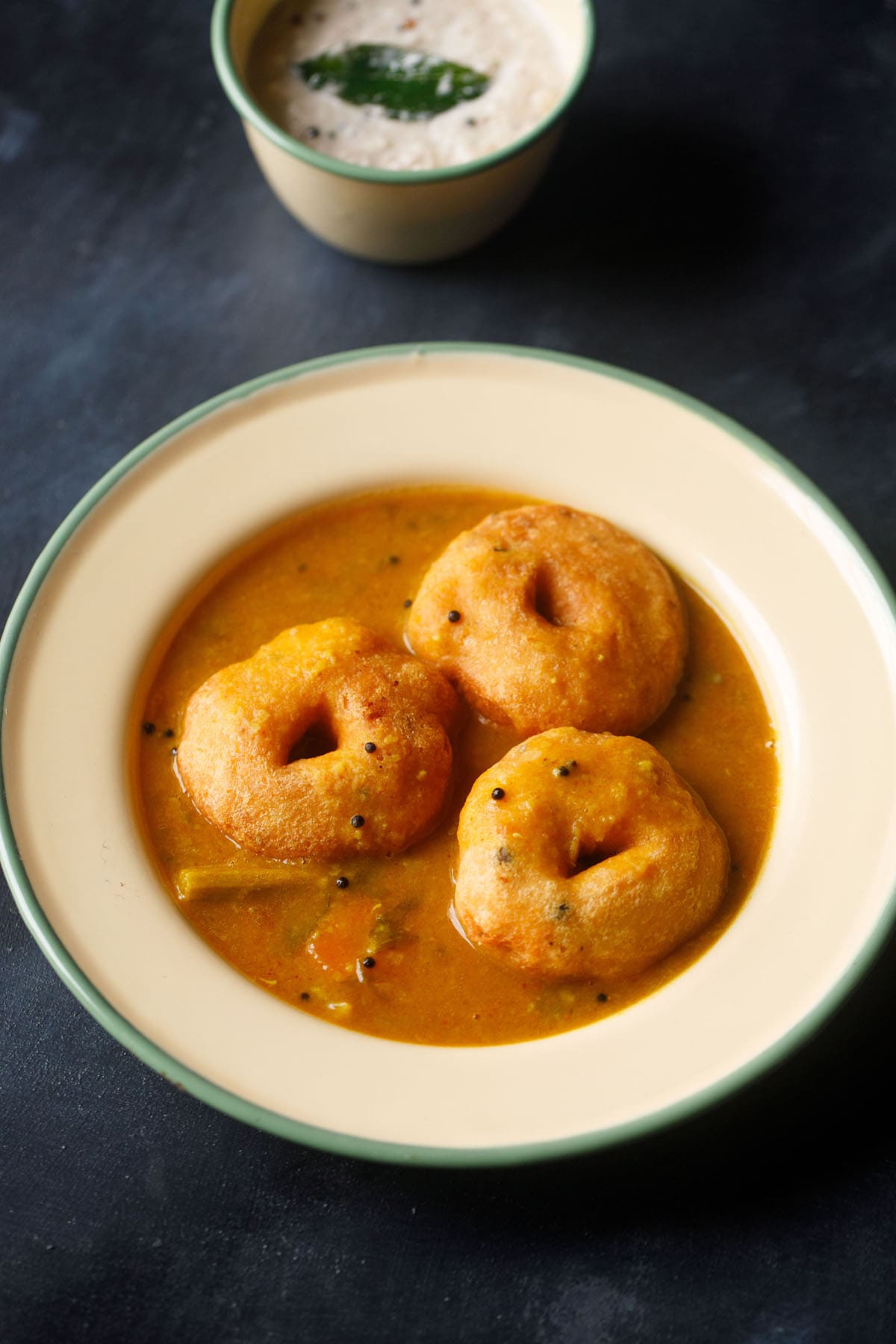
Sambar Vada
To make sambar vada, you can make any of the sambar varieties I have listed below. Depending on the veggie stock in the kitchen, I make sambar with just one veggie or a mix of various of them.
Vada and sambar are a match made in heaven, so even if you make your sambar without any veggie, it will still be a joy to eat.
- Sambar – Classic South Indian Sambar made with mix vegetables, lentils and sambar powder
- Hotel Style Sambar – If you love hotel style flavors in your sambar, you will love this variation where the sambar masala is made with freshly roasted spices and lentils. You can even pair this sambar with idli.
- Onion Sambar – This sambar features small onions or pearl onions together with lentils, tamarind and spices.
- Drumstick Sambar – A variation made with drumsticks which are fresh moringa pods and tastes too good with medu vada.
- Arachuvitta Sambar – Is made with coconut ground with freshly roasted spices and has a fantastic taste and flavor.
FAQs
Uh-oh, sounds like one of two things happened. If the batter is thin, then the vada will absorb too much oil during frying.
But even if the batter is perfect, you need to heat the oil properly – if it is warm or not hot enough, the vada will also turn out greasy.
Ooops, sounds like you didn’t blend/grind the batter enough. When the urad dal is almost the consistency of whipped cream, you have reached the right consistency.
Be sure to use a powerful (750+ watt or more) grinder or blender or a table-top wet grinder for the best results.
Also, please be sure to soak the urad dal for at least 4 to 5 hours or even overnight. If the dal aren’t well soaked, they will not grind to a soft, fluffy batter.
Ensure that you use fresh urad dal in its shelf period. Aged or old urad lentils will take a lot of time to grind or blend and can also make the vada dense or hard.
Sounds like your batter was too thin. Try adding a bit of rice flour or semolina to the batter to thicken it up; it should be the consistency of a thick cake batter or like whipped cream.
As with most donuts or fried goods, these savory fritters are best served hot from the frying pan (after draining oil, of course).
That said, any leftovers will keep for up to a day. To reheat, warm them in an oven until hot to the touch.
You can also make the batter up to 1 day ahead of time. Keep it in the fridge until you are ready to fry. Let the batter come to room temperature before frying.
Absolutely; it can either be halved or doubled depending on how many vada you want to make!
I use either sunflower or ground nut oil for deep frying, but any neutral oil with a high smoke point will work. Safflower, vegetable, or peanut oil are all acceptable substitutes.
More Popular South Indian Snacks!
Breakfast Recipes
Breakfast Recipes
Breakfast Recipes
Breakfast Recipes
Please be sure to rate the recipe in the recipe card or leave a comment below if you have made it. For more vegetarian inspirations, Sign Up for my emails or follow me on Instagram, Youtube, Facebook, Pinterest or Twitter.
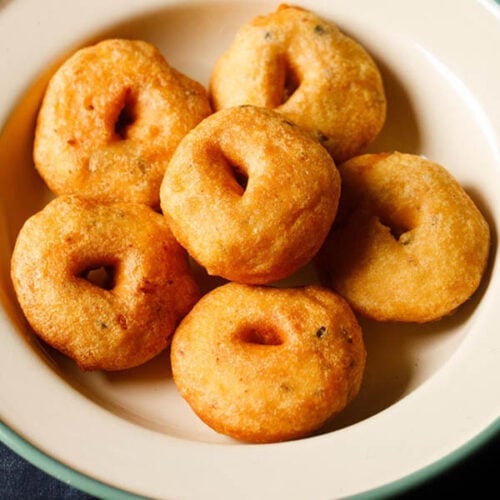
Medu Vada Recipe | Sambar Vada
Ingredients
- 1 cup urad dal (husked and split or whole black gram) – 200 grams
- 2.5 to 3 cups water – for soaking
- 3 to 4 tablespoons water – for grinding or blending lentils
- ½ teaspoon cumin seeds
- ½ teaspoon black peppercorns whole or crushed
- 1 tablespoon chopped curry leaves or 7 to 8 curry leaves
- ⅓ cup finely chopped onions – optional
- 1 teaspoon chopped green chilies or 1 to 2 green chilies
- 1 teaspoon finely chopped ginger
- 1 pinch asafoetida (hing) – optional
- ¼ cup chopped coconut pieces – optional
- 2 tablespoons chopped coriander leaves – optional
- ½ teaspoon salt or as required
- oil for deep frying, as required
Instructions
Making Vada Batter
- Rinse urad dal a couple of times in fresh water. Then soak the lentils for 4 hours or overnight.
- Grind or blend the soaked lentils to a smooth batter with water.
- If the batter becomes watery, then the instant relief would be to add some semolina or urad dal flour or rice flour to it.
- Add all the spices, herbs and salt. Mix well.
- Take a bowl of water. Apply some water from the bowl on both your palms. Take some batter in your right hand from the bowl. Give it a round shape by moving it around.
- With your thumb make a hole in the center. You can also use banana leaves or zip lock bags to give the medu vada its doughnut shape.
Frying Medu Vada
- In a kadai (wok) or pan heat oil for deep frying. Keep the heat to medium.
- Once the oil becomes hot, slid the vada gently and carefully into the hot oil.
- Shape the batter this way and gently slid them in the oil. Don't overcrowd the kadai or pan with the vada.
- Once the vada is slightly golden then gently turn over with a slotted spoon and continue to fry.
- Fry them till crisp and golden. The oil should be not very hot, but medium hot. You want the vadas to be cooked from inside. Very hot oil will quickly brown the vadas from outside but they will remain uncooked from inside. Less hot oil will make the medu vada to absorb too much oil. Even if the batter is thin then also the medu vadas will absorb too much oil.
- Fry all the medu vada this way till they become evenly browned and crisp.
- Drain them on kitchen tissue to remove excess oil.
- Serve the medhu vadai, hot or warm with sambar and coconut chutney. It can also be served with other dips like mint chutney, coriander chutney, tomato sauce or onion chutney, tomato chutney etc.
- One of the best combination is sambar vada where these medu vadai are dunked in piping hot sambar and served with a side of coconut chutney. This vada sambar meal is finished with steaming hot filter coffee.
Nutrition Info (Approximate Values)
This medu vada recipe from the blog archives was first published in October 2011. It has been republished and updated on Jun 2022.

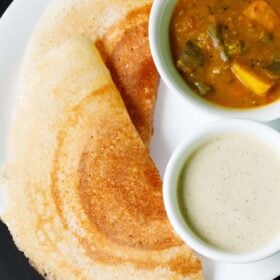
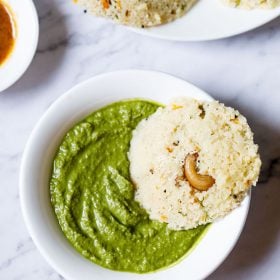
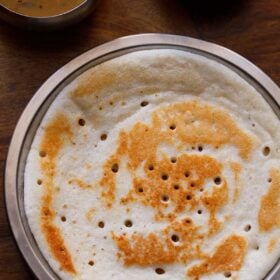











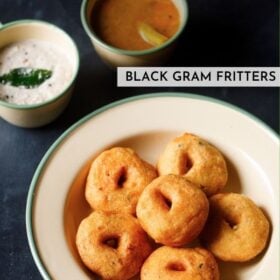
Good.
Thank you Dassana! Thank you! Finally I did it!
I made the simplest vadas with minimum of ingredients but they were SO good!!!
And my family loved them👍
Want them again.
Great and thanks for this lovely feedback. Happy to hear! Most welcome.
Came out soft and tasty!! Thank you 🙏
Welcome and thanks.
Everything is fine, but they became a bit hard. Maybe I put too little water , or shall I fry them less?
I see someone commented that step by step instructions are better than the video – yes, clearly so. Clear detailed instructions is the main reason why I have been using you page since 2013 I think.
There are many cooking websites, but this is what makes yours the best!
Could be they are not ground very well enough or can be due to less water. Sometimes older lentils also make for hard texture.
Yes, even I think that step-by-step photos are helpful than videos. Thanks a lot for the kind words. Truly appreciate it.
Excellent soft vadas. I couldn’t manage to make the hole in them, but they were delicious.
Thats alright. They taste good even without them having a donut shape. Thanks for the feedback and the rating on the recipe.
Hi Dassana
The vada was a super duper hit with my family. Really came out soft, fluffy, crispy and very tasty as i followed the instructions without any variations whatsoever. Never before did it come out so well.
Thank you so much.
Happy to hear that and thanks a lot for this super feedback. Thanks for the rating too.
Turned out soft and very tasty
Thank you 🙏
Welcome and glad to know.
in some restaurants size of medu wada is double the size as shown by you , my Mother in law says– they might be adding cooking soda to make them such big and fluffy –what is your opinion — about size– its more some thing XXL
Yes, even I have seen that and I also would wonder. I think they may be having some press/equipment to make the large sized vada. I am not sure about the baking soda part though.
Hi Dassana thank you for the wonderful work could you teach us how to make vegetarian baked ziti.
Thank you Bhavya. Yes the recipe is in my drafts and one which I make often.
This recipe is superliked in my family
Thank you for this feedback and the rating as well.
I love all recipes and also try them at home
They all are with clear description and easy for learners. With the help of photos it gives clear picture and texture to understand.
Thank you
I just love your page.
Thanks a lot Aayushi. Glad to know that the details and photos are helpful. Most welcome.
Hi, I made medu vada today for evening snacks. It came out very well but I didn’t get donut shape and I can’t make hole
thats fine. it requires some skill to get that donut shape. if you are not able to get it, then also it is fine.
Nice. I have seen a lot of videos in youtube.com for making vada. But even though there is no video here, its clear and to the point. Thank you.
thank you. your comment has cleared my confusion of videos vs stepwise photos. i am glad that the steps and photos worked here. very few readers comment on the layout or on the structure of the post or recipe. so it does help when we get comments like yours. thanks once again.
How much daal needed for 200 vadas
you will need about 20 cups of urad dal which is 4 kg of urad dal. 1 cup weighs 200 grams of urad dal and makes for 10 to 12 medu vada.
Hi dasana
Is 2 cups urad dal not too much for 4 persons.
hi vijaya, you can halve the recipe and make for 4 people. this recipe was posted and made when there were 8 people living as a family. but you can easily halve the recipe by changing the servings to 4. i have now updated the servings to 8 which was a typo error. i will soon update this recipe with better pics and changed recipe ingredients ratio.
Please post the recipe of veg egg curry.
have taken your recipe request and will try to add.
Hi Dasana, The explanation is too good and perfect. I made medu vada yesterday and they came out well. It is just that they were a bit harder to break. I have gone through all the comments and now I know exactly what went wrong. Although the batter was floating,it was not fluffy enough. I will give it one more try. Thanks a lot for sharing such wonderful recipes.
thanks shaily. if the batter is ground very well than the vadas become soft. the batter should be light and fluffy and in resemblance look like similar to whipped cream. this consistency is achieved easily in a table top wet stone grinder. for a mixer-grinder one just need to grind the lentils till fluffy and smooth. in case the mixer or grinder gets heated up, then wait for some minutes and start grinding again. a powerful grinder also does a good job.
Yes Sure. I will keep this in mind next time and let you know how it turns out !!
sure, do let me know.
Hi, i want to know if the batter can keep in fridge?? Waiting for your mail. I like ur meetu vadai recipe…. Tq
yes you can keep the batter in fridge, but use within 1 or days.
I am a big fan of yours. If there is one website I trust when it comes to cooking, then it yours. I know for sure that the cooked item will turn out great. Thanks for all your wonderful recipes. Tried medu vada today. They came out really well. The batter was slightly watery. So I slightly fried them. Then made a hole and refried to get donut shape :D.
Welcome Swathi. Thanks for your kind words and the trust you have on the website. I try all the recipes before posting them. Thanks for sharing positive feedback on medu vada.
Hi Dassana,
My earlier attempts to make medu vada(not your recipe) in the past had resulted in the vadas bursting during the process of deep frying them.Since then I haven’t had the courage to try them again though my hubby loves vadas…can you think of why these would burst in hot oil?
ashwini, if the batter is thin the vadas will burst in oil. the batter has to be thick to medium consistency. after grinding try add 1/2 to 1 teaspoon of batter in a small bowl of water. the batter should float. if the batter dissolves in water, then add some rava or rice flour to it.
Hi Dassana! I’ve tried many of your recipes including this recipe for Medu Vada and they are all really tasty! Thanks for all the recipes you’ve shared and I hope you’ll continue to share! (p.s. You have the best recipes for Indian veg cuisine)
welcome jing yi. glad to read your positive feedback on recipes. thanks for this awesome feedback.
Hi dasana,your recipes are very helpful for me,I tried your medu vada recipe,the taste n shape of vada were perfect only it was too hard to break the vada.can u help me to make soft vada’s…
Thank you
afreen for making medu vadas, always use urad dal which is fresh. the more aged the urad dal is the more hard the vadas will be. also soak in enough water and when grinding, grind to a smooth fluffy batter. the batter has to be ground really well. it should look fluffy somewhat similar to whipped cream texture. in a mixer-grinder, this cannot be achieved as the grinder will get heated up. so try to grind in intervals and grind till you get a nice smooth consistency in the batter. if required, then you can add a few tablespoons of water while grinding. hope these suggestions helps.
Hi dassana! I tried this recipe of ur twice it turned out good .. as my hub ND me are from.bangalore he want me to cook south Indian food coz at present we live in Qatar … so ur website helped me a lot .. can we add ginger garlic paste while grinding as I don’t have ginger??
thanks fazila. you can ginger-garlic paste. but when garlic is added the taste will change slightly. if you are fine with the taste, then you can add ginger-garlic paste.
Thank you once again
Welcome Fazila
HI
I MADE DOUGH FOR MEDU VADA BUT I COULDNT MAKE IT IN SHAPE
the batter should be thick in consistency. if its medium to thin consistency, then its difficult to shape medu vadas.
Thanks for the medu vada recipe with step by step procedure.It came out excellent.I have tried many of your recipes,all of them turn out to be yummy n delicious.Your step by step explanation and note help a lot.
Welcome Soumya. Glad to know this. Thanks for sharing your positive feedback on recipes.
All recepies r best
thanks durriyah.
Hello Amit! It’s always a pleasure to try your recipes. I have downloaded the veg recipe app as well..anything new that I would like to make I read many recipes but finally follow yours . It’s easy, delicious, and step by step pic makes it more easy. Thanks a lot..you are helping when mom’s not around ..all the best and success to you always..god bless
welcome sonal. glad to know that you like the recipes and their presentation. thanks for sharing your motivating feedback.
Hi Dassana,
Most of the times (read 98%), I look up to your recipes and website, latest tried being pineapple kesari, I tripled the quantity, the final product aroma wise, consistency and texture wise, in terms of appearance and taste, was just perfect. I just don’t scratch my head for measurements (exceptions are there), work it out accordingly 🙂
Fantastic space and job, kudos!
One small thing that I have noticed in quite a few posts. You use ‘Udipi’. Actually, it is Udupi, we pronounce ‘du’ as in ‘do’ and not ‘di’ as in ‘dim ‘.
thanks a lot chetna. glad to know that tripling the pineapple kesari recipe worked very well. in mumbai, the term ‘udipi’ is used and even written on hotel signboards. thats why i use the word ‘udipi’. i know it is udupi, but i am so used to seeing udipi and thats why its gets reflected on the posts too. will make a change in the recipe names.
I made vadas as per ur recipe n it turn out very yummy..it was my first attempt to make medu vadas and I m extremely happy with the result. I am following u from almost a yr. I m simply love with ur teaching style ur best.
thanks a lot avanti. glad to know. happy cooking and i hope you like the recipes which you will try in the future.
I made medu vada as per your recipe….it tasted awesome…just one thing it was really oily…on what temperature should I cook it so that it does not have a lot of oil.
thanks neha. if the the batter is liqiudy, meaning more water is there in it, then the vadas will absorb more oil. also if the vadas are fried on a low flame or on low heat or the oil is not hot enough, they will absorb oil.
It tried it… It was amazing… Still the taste remaining in my mouth n in my mind.. thanks for the recipe..!!
thank you hima for this feedback.
superb…you made my life easy as was difficult to make new items for kids tiffin. …keep it up and give us more recipies
sure we will keep posting new recipes 🙂 shweta and thanks for your positive feedback.
Respected Ma’am, I prepared medu vadas again. This time I made the batter little soft and fluffy by adding little water and baking soda. I grinded it very very well. This time the vadas came out to be very soft and delicious. I realized last time my vadas were hard as I had not grinded them well, even the batter was not fluffy, I had not added even a single drop of water last time. But this time I was very careful and followed all your instructions and the results were very good. Only one problem is the grinding of batter takes toll of our patience. No matter at end all is well. Thank you once again..
thanks for sharing vijay. glad to know 🙂
for the grinding, i would suggest you to invest in a good grinder with higher watts. the grinding is faster. you can also use a table top stone grinder. though lifting it and cleaning can be a task. i am using preethi blue leaf 750 watts mixer grinder and it grinds the urad dal faster, then the other mixer grinder i have used in the past.
Thanks dassana for the recipe!!tomorrow goin to try my favorite vada for the breakfast..
surely try sowrirajan and let us know how the medu vada was? thanks.
My girfriend is from south…so to impress her I made vadas according to your recipe…n guess she now love me than before…thanks a lot.
pleased to know this surya thankyou for trying the medu vada recipe and you are welcome.
Thanks u very very much Sir. Next time I will try with ur suggestions and give u the feedback.. Thanks once again…
surely vijay thank you so much and you are welcome.
Dear sir, I made medu vadas as per ur recepie the taste was awesome. But one problem was there that the vadas were little hard to it. I did not add any water while grinding nor did I do frementation. Can u plz suggest me how to make them soft without fermentation.
medu vadas do not need fermentation. hardness could be due to the batter not being ground properly. the batter should be light and fluffy. even if you briskly stir the batter, with a spoon for a couple of minutes, the vadas will be soft. a bit if water added while grinding will also make them light and soft. before frying, check a small piece of the batter in the oil. if its soft and and light, then the batter is good. if it is hard or dense, then add 1 to 2 teaspoons of water and/or stir the batter briskly with a spoon for a couple of minutes.
Good Information for break fast.
thankyou ramkisan 🙂
Hi, thanks a bunch.
I came across your site when I wanted to save myself from the little disaster I made.
I had washed the lentils dried them roughly for 2 hours and ground tthem in a dry jar.
Soaked overnight. Morning woke up to see the cconsistency gone thin.
Your one line to add semolina saved me.
Thanks. The batter is yet to be tried this eevening.
I was told by my sis to add a pinch of soda to the batter 5-10 minbefore frying.
you are welcome ash and let is know how the vada was?
Hello there,
I’ve been cooking south Indian food for around 1 year. My husband is from Bangalore and loves when I make his “home food” (we currently live in the UK)
Your medu vada recipe is the best I have tried so far! He tells everyone how great my vada is… I can’t take credit! Thank you so so much for providing this tasty recipes.
Only problem is… I’m addicted to vada now haha!!!
I was just wondering how long the batter lasts? Ive used it the next day, would it last 2 days in the fridge?
Thanks for your time!!
thankyou so much elizabeth glad your husband liked the medu vadas 🙂 the batter should last for 2-3 days in the fridge just refrain from adding salt to them for a longer life shelf. hope this help’s you.
Really its help a lot thanks its really worthy I mean your recipe is very simple that’s the favourite part of this
thankyou so much Jaipal 🙂
Thank uuuuuu so much for ur recipies…….,
welcome and thankyou Anjali 🙂
Hello…thnk u soo much fr ol d lovely receipi …u explain everything vry nicely. .n especially ur explanation with step by step images make everything easy..well m in graduation bt only bczz of ur site. .I ll able to make each n everything. .thnqqqqqqq sooo much:-):-)
welcome pratibha. glad to know this. thanks for sharing your positive review.
Well, this is getting predictable. Oh yes, yet another brilliant success story. ? The recipe is food Luddite proof given the water floating test. It was great fun adding a few drops and grinding until finally, at last, the floating happened. If only there was such a test for the fermented batters….I could graduate the idli, dosa and appam classes with honours instantly without so much homework. Vadas are sooooooo easy, especially when you have Dassana teaching you from her virtual kitchen. With her help I now have my PhD in Vada management – after only one class!
So were they any good? Well let’s see if the empirical evidence stands up in court. “So Dr Vada, did you or did you not serve your wife Vadas with coriander chutney? Also with yoghurt and Imli?” Yes your honour she had Dahi Vada, I drowned it in yoghurt and drenched it in imli sauce. She then proceeded straight away to drown another in coriander chutney.” “Hmmm and did you bring any Vadas for me to taste?” “No your honour they were all gone, I turned around and all 10 were missing.” Hmmm, unacceptable, I sentence you to cook 30 Vadas a month for your wife.” ?
thank you rohit as always. the way you write is really good and brings a smile every time i read your comment. the water floating test is the true test to check the consistency of the batter. for the fermented batters, there is no such test. its just practice and experience that is needed for the fermented batters.
What is the oil used to make .which one makes less absorb .is it groundnut or sunflower oil
i use both sunflower and ground oil for deep frying. to make the oil get absorbed less, the oil has to be hot whenever you fry any food in it.
Hello, I recently started cooking and most of my learning has come from your site as that’s the first one which pops up when I type any recipe name in Google. So thanks for your guidance.
Anyway I made medu wadas today following your exact recipe, but they turned out hard, I had soaked whole skinned urad dal for about 11 hours, what could have gone wrong?
the batter needs to be ground very well and should be fluffy. if the batter is not ground well, then the vadas become hard.
Thanks . Adding rava made vada yummy.
welcome sheetal
Hello Dassana and Amit.
First of all. let me congratulate you both on your excellent website and the pleasure, and knowledge, it has given to millions. 😉
Next, … I am so old, that when I first came across your name …. the first thing I could think of was ….. ‘thats more than half a rupee – Dus anna is more than 8 annas !’ . Old joke.
Today, is March 14, 2015. Saturday. …. in the US known as ‘Pi’ day. Because Pi = 3.14 15 926 53 hence under the US convention – 3/14 – the 14th of March, (20)15, at 9.26 am, and 53 seconds past.
Anyway, at 4 am this morning I decided I wanted to make Medu Vada. I have not made it in 4 years because my wife hates oily fried food, with a passion. But I had dreamt of it, last night, so I woke up surreptiously, like a cat, and went downstairs to use a Gits mixture for the vadai. The Gits packet was outdated, by 3 years, so useless, and I decided to make it ‘from scratch’. My wife wakes up at 4 am everyday, to go to work – but today, being a Saturday, she was still asleep snoring like a cat in catnip heaven. Since it is -8oC outside, I warmed a bowl of water and soaked 2 cups of split urad dal, and waited for an hour. Meanwhile I made some sambar with 3 pounds of exotic indian vegetables like ridged gourd (luffa – turai, turiya )and shallots and tendli (ivy gourd) and made a good sambar. Then I read and followed your recipe , ground the urid, added hing, ginger and green chillies, and fried in hot oil. And it came out great.
Then I rushed upstairs, and woke the wife, and gave her the steaming dish. Then I asked her.’Honey, how does it taste?’….. she ignored my question and asked one of her own,’How much peeth (dough) did you make?’. That line is worth a paragraph …..
It means – I really dont care about how good the food is —- but I KNOW you probably made a tonne of it and we’ll be eating medu vadas, out of our nose, for the next 6 weeks, ….. until we are sick to death, and I will have to make a garland of vadas and wind it around your wretched neck, and hang you upside down ….. After 35 years of married life, my wife has superlative ESP…
Enjoy the rest of the day, and the coming week. ;-D)
thanks gary ji for this sweet as well as humorous comment. i must say you are a good writer for someone who likes to read in leisure with a cup of tea. your comment reminded me of my grand father who use to tell that there use to be 16 annas in one rupee… and from 1 rupee or few annas how much ‘mun’ (unit for measurement) of flour or rice could be bought in good old days. women are always practical as far as household things are concerned. wishing both of you a nice day.
Dear Dassana,
Thank you for your reply and also for not deleting my post …lol. ;-D) I nearly deleted my own post, because it appeared to be so irrelevant and irreverent of your blog. ….. ^_^ ….. Despite of what I wrote yesterday, I am very appreciative and very much in love with my wife – and I think I am the luckiest man in the world, SOLELY because of her.
I was born in independent India, and until a few years ago, when I started losing my eyesight (long story – ) – I was an avid collector of old Indian coins and currency notes. I have all the original coins that were issued pre-independence and post- indep and also a Bombay mint issue that was a commemorative of the actual independence (day – )of India – which says ‘Jai Hind’ , on the obverse and reverse sides, and was distributed free to all the schoolchildren, in the schools, on that day, 8/15/1947. I also have 10 and 20 Cash (Kasu) coins from Madras, of the East indian co. ( Yes, ‘cash’ was a tamilian east india co. coin – ) and also a ‘Chukram’ ( a coin from the esrtwhile Travancore state). One Travancore Rupee = 7 Fanams , 1 Fanam = 4 Chuckrams, 1 Chuckram = 16 Cash. Plus to make it more complicated, One British India Rupee = 28 Chakram 8 cash. (!!!) …. and One Travancore Rupee =15 annas and 6.83 pies of British India. (per Wikipedia – ).
No wonder indians have to be so good in math and addition and subtraction. ;-D))
Have a great week, and continued good wishes for your website and blog.
welcome gary ji. i found your comment interesting. previous comment will be appreciated by many foodies so how can i delete it. the coins which u have collected is antique now. most of us have no idea about the old style currency and coins. i liked reading it. i hope someone from your generation pen down all this interesting info so that its not lost. i must say again, you have a good style of writing.
What makes idli vada and sambar great is, idli must be grainer (use idli rice/rawa), Vada must be less dense and more crispy so that it can soak in sambar.
There are many techniques to attain this for example, always grind urad dal using stone wet grinder, this ensures pluffy consistency of batter.
Adding cooking soda or semolina gives crispness.
Another technique is deep frying twice.
thanks for these tips and suggestions madhusudhan. i have a stome wet grinder now and it does make a lot of difference to the idlis and dosa texture when grinding urad dal. the same fluffiness can be achieved in a mixer-grinder. for medu vada i use the regular mixer-grinder to grind urad dal, but for dosa and idli i use the stone grinder. agree on cooking soda and semolina. deep frying twice is new to me. never tried this way.
Thee recipe sounds really good. but when I tried to make them fluffy the. vada turns out flat. do I have to add yeast to the batter..If so. then how much?
the vadas turned out flat as it has more water. just add a few tbsp of rice flour or rava to thicken the batter.
Nice
Medu vada was very tasty and nice..thank u so much..i tried ur lauki ka halwa reciepe also..it ws very yummy…
welcome shubhangi. glad to know this.
Hi..thanks for all ur recipes..m goona try medu vada tomorrow for d 1st time..
welcome shubhangi. happy cooking.
Vadaa will try.. Thanks for all recipes…
welcome gita
Its really a nice article on indian recipe.i love to cook different kind of foods..keep giving us more innovative recipes…
sure subhamoy
I like wade
tried vada. thanks really. . ur recipe helped me lot
welcome savita
Very nice recipes I tried at home , thanks for all the recipes specially vada
welcome apurva.
Hi thanku for all ur recepies i am newly married and new to kitchen and ur blog always help me in all kind of recepies
welcome vaishali. glad to know that recipes are helping you.
Hi am trying it out now…….dnt knw hw it comes
Hi Dasanna
Messaging you just having a plateful of yummy vadas…turned out perfect. I tried makng the doughnut shaped vadas. But I guess, its not my forte. Hence, settled for the spoon version 🙂
shruthi, it takes a lot of practice to make vadas that way. spoon way is easier.
Hi dassana, very nice receipe I tried at home.. It’s really tasty..
Only issue is with the shape of the vadas which I couldn’t get as in the pics showed.
If you could tell little bit any tricks on getting the proper shape would be really great.
Anyways thank you so much for the receipe
thanks supriya. what i do is i apply some water on my palms. then take a portion of the batter and using both the palms, i give it a round shape. then just press the thumb of the right hand in the center of the batter, which is in my right palm and slowly slid the vada in the oil. but this method is a bit complicated. so you can take a zip lock bag or a banana leaf cut out. smear some oil on either the zip lock bag or the banana leaf. place some batter on it and flatten & shape it round with your hands. apply some water on your hands when doing so. then make an a dent in center. then slid the uncooked medu vada in the oil. if you cannot do any of the above, then just take the batter with a spoon and fry them.
Hi. Thks for telng thz receip. I Staying in south india u hv tld a perfect receipe which v make. Bt i hv a doubt tht hw those vadas wil become crispy. Shal i mix anythg in tht plz suggest me
vadas are always crisp. to get more crispness, you can add 1 or 2 tbsp of rava.
QHI MADAM NICE DESCRIPTILN. I DONT HAVE OVEN . I WANT TO STORE MEDU VADA FOR THREE HOURS CRISPY. PLS TIP
medu vada won’t stay crisp if you keep them for 3 hours. at the most you can just keep them in a foil or a in casserole. they will be soft but the crispness won’t be there.
hii u have done good job.thanks for clear instruction…
welcome sonali
Hi I made medhu vadas today and they were awesome..I could get exactlythesame as urs..thanks for the clear instructions..
welcome suhani
thanks a lot!!!
welcome deepa
Good work. Really interesting. Will try.
If u can plz give this ans??
We have to soak first urad daL or after grinding.?
My usually do it after grinding?
kashyap, you have to first soak the urad dal for 4-5 hours or overnight and then grind it.
Hi Dassana,
You explained this very clearly
I loved ur photos as always
.
Please clarify a doubt. I have to make a large batch early morning soon
Can i make the batter the night previous and refrigerate it and just fry it in the morning
I am concerned it may absorb too much oil
Many thanks
you can make the batter and refrigerate it. let the batter come to room temperature before frying. it won’t absorb too much oil.
Hi,
I am following your veg recipes , good job 🙂
I tried Medu vada but it turned out very hard following your recipe . can you tell me where i must have gone worng ? thanks
hi shifa, for how long did you soak the urad dal. the longer they are soaked the fluffier the batter gets while grinding and the medu vadas become soft. since its winter time, i would suggest to soak the dal for a few hours more. i have experience of cooking medu vadas often. when i soak them for 1 or 2 hours, the vadas don’t become soft. when i soak them for 4-5 hours, they are soft and they are too good when i soak them overnight.
I am just trying to get my mum convinced to let me make these 4 a school assignment 🙂
Hi Dassana,
…. Could you let me know the secret to soft medu vadas… mine always turn hard after sometime
there are few tips that i can share that will make the vadas soft:
1: soak the urad dal for a good amount of time.
2: overnight soaking is the best. i have seen that when i soak the urad dal overnight, the medu vadas turn out really soft, then when i soak them for 3-4 hours.
3: if possible then avoid water if you can or add very less water just to aid the grinding process.
4: while grinding, add water in batches in between the grinding process. this incorporates more air in the batter.
5: also stir & scrape the batter from the sides in the grinder in between grinding.
6: you can also keep the batter for 30 min or 45 min at room temperature to make them more soft.
i hope these tips help.
hi dassana…i couldnt make the wadas as ur pics depicts as i couldnt make a hole in between and drop the wadas in the oil right away..so my wadas were in a very bad shape..although the taste was good..anyways i’ll try next time..
even i cannot do it properly. my mom is an expert in making the vadas and i cannot even come close to the way she shapes and makes them. i usually just spoon the batter in the oil and fry them. anyways there is a always a next time 🙂
Very good recepie….Neatly explained……Thanks….Let me soak my dal straight away.
thanks sandhya.
When is your recipe for sambar going to cpm i am waiting coz whenever i make it turns out miserably horrible.pls do give sambar post
take care
very soon i will post a sambar recipe, sunita. i make different types of sambar often and there was a time i have experimented with sambar so much. there are a few links you can read from the website that can help you:
https://www.vegrecipesofindia.com/kerala-sambar-recipe-kerala-sambar/
https://www.vegrecipesofindia.com/south-indian-delicacy-sambhar-recipe-ingredients-and-preparation/
https://www.vegrecipesofindia.com/sambhar-recipe-a-method-made-easy/
Thank u so much….
Gosh I have never seen such awesome pixs of the medu vadas and the receipe is also given so beautifully my fly and myself live in NZ and its so expensive to buy these from Indian shops hope I can make them for my fly. Thank you so much for them . Going to try out the idlis too as we just love south indian food and miss it so much.Just waiting to go home and make all this for this weekend.
thanks anjum. i know even abroad a plate of samosa costs too much. here one plate of samosa is 10 or 15 Rs, if you buy from a sweet shop. but the same plate of samosa will cost around 50 Rs with taxes etc in cafe coffee day outlets.
its always better to make snacks like these at home. do lemme know how the medu vadas turned out.
yummy looking crispy vada looks wonderful
I notify and iam following up
thanks aisha
The reciepe is so tasty,
I love medu vadas with my idlis! I have never attempted making these at home though 😉
Yours looks perfect! Crisp on the outside and soft on the inside…
thanks chinmayie… you must try making the medu vadas at home 🙂
Hi,
Thank you for the recipe. I had tried this recipe some time back and it had come out very well. . But this time I don’t know what happened, I slowly placed the batter in the oil and after couple of minutes the Vada started breaking and oil started spluttering all over. I turned off the stove and got scared so much that I gave up doing it. I had used wet grinder to grind it and started making it after keeping the batter for 30 minutes. The batter was super soft and fluff. Do you know what could have gone wrong with it?
welcome vinutha. the batter has to be thick. it has become thin. thats why the vada was breaking in the oil. to correct the consistency of batter you could have added some rice flour or rava to it. after that you could have made the vadas. such things happen while cooking.
Thanks for the simple instruction. Tommorow I shall tell my Filipino cook to make some Vadas. Being only vegetarian on board I have to start exploring further dishes also.
surely try the medu vadas and let us know how it turned out? thankyou and you are welcome.